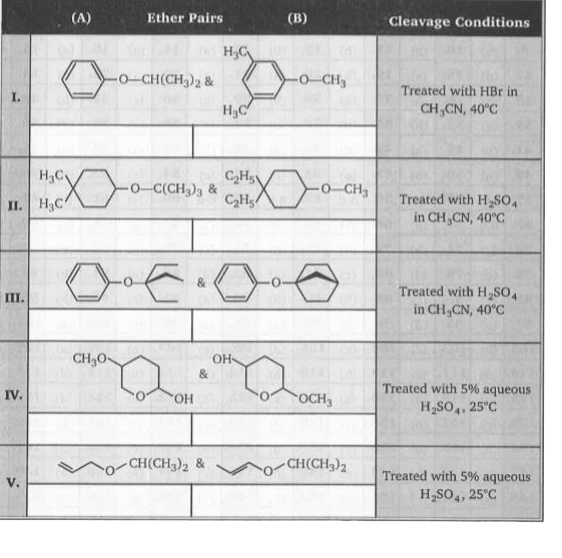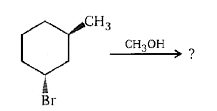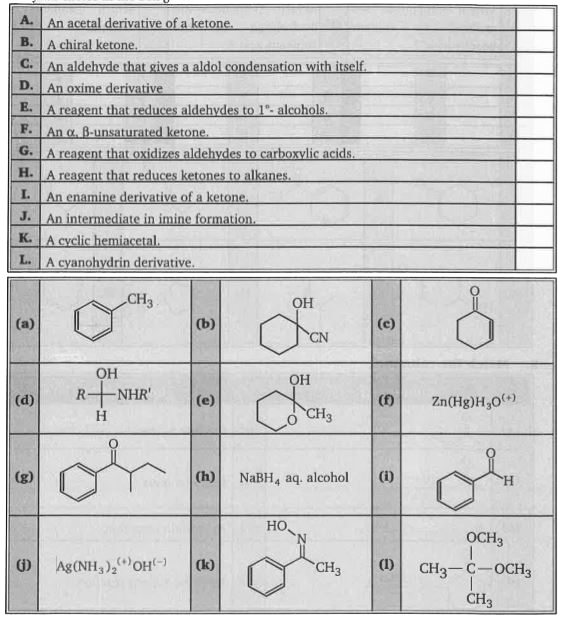Ph−O∣∣C−O−H+CH3−O18−HH+⇐⇒(X)+H2O, Identify X : Solution in Kannada
X=Ph−O∣∣C−O18−CH3 (Trans esterfication )
X=Ph−O∣∣C−O18−CH3 (Esterification reaction )
X=Ph−O∣∣C−O18−CH3 (Saponification)
X=Ph−O∣∣C−O−CH3 (Hydrolysis)
Ph−O∣∣C(acid)−O−H+CH3−18O(alcohol)−H⊕⇐⇒Ph−O∣∣C(ester)−18O−CH3
Topper's Solved these Questions
- BOOK - MS CHOUHANCHAPTER - ALCOHOL,ETHERS AND EPOXIDESEXERCISE - LEVEL-224videos
ALCOHOL,ETHERS AND EPOXIDES
- BOOK - MS CHOUHANCHAPTER - ALCOHOL,ETHERS AND EPOXIDESEXERCISE - SUBJECTIVE PROBLEMS1videos
ALCOHOL,ETHERS AND EPOXIDES
- BOOK - MS CHOUHANCHAPTER - 5C ALKYL HALIDES EXERCISE - LEVEL-2 (SUBJECTIVE PROBLEMS)1videos
5C ALKYL HALIDES
- BOOK - MS CHOUHANCHAPTER - ALDEHYDES AND KETONESEXERCISE - LEVEL-220videos
ALDEHYDES AND KETONES
Similar Questions
Consider the pairs ofethers, numbered I throughV, shown below. To the right of each pairis a description of reaction conditions to be applied to each. One compound of the pair will react more rapidly than the other.
Which ether of the two will be more rapidly cleaved?
Write your answer in box.
 View Solution
View Solution
Maximum number of moles of Ac2O consumed by reactant (A) is :01:53View Solution
X = Total number of substitution and elimination product(s). Find the value of X.05:02View SolutionSelect the best choice for example (A to L) from the examples (a to n) given below. Write your choice in the box given.

 01:57View Solution
01:57View SolutionCH3−O∣∣C−H and Ph−O∣∣C−H can be differentiated by :
01:57View SolutionCH3−O∣∣C−H and Ph−O∣∣C−H can be differentiated by :
View SolutionRupturing of the O-H bond in CH_3-underset(H)underset(|)overset(H)overset(|)C-O-H is shown by reaction
03:28View SolutionIdentify and name the functional groups present in the following compounds. ii. H-overset(H)overset(|)underset(H)underset(|)C-overset(H)overset(|)underset(H)underset(|)C-overset(O)overset(||)C-O-overset(H)overset(|)underset(H)underset(|)C-H
01:02View SolutionIdentify and name the functional groups present in the following compounds.
ii. H−H∣C∣H−H∣C∣H−O∣∣C−O−H∣C∣H−H02:32View SolutionColumn - I (A) CH_3-overset(O)overset(||)-O-overset(Ph)overset(|)underset(Ph)underset(|)-Phoverset(H^(oplus)//H_2O)to (B) CH_3-overset(CH_3)overset(|)underset(CH_3)underset(|)-overset(O)overset(||)C-o-Ph overset(H^(oplus)//H_2O)to (C ) CH_3-O- overset(CH_3)overset(|)underset(CH_3)underset(|)C-CH_3 overset(H^(oplus)//H_2O)to (D) CH_3-O-underset(CH_3)underset(|)CH-CH_3 overset(HI)to Column-II (P) Unimolecular (Q) Bimolecular (R) Alkyl oxygen bond cleavage (S) Acyl oxygen bond cleavage
02:55View SolutionIn the given sequence of reaction, identify Y C_6H_5-overset(O)overset(||)(C )-CH_3 overset(SeO_2)to X underset((ii)H_2O // H^(o+))overset((i)Conc. NaOH//Delta)(rarr)Y
01:19View SolutionThe IUPAC name of CH3CH2−O∣∣C−CH2−O∣∣C−H is
01:53View SolutionReaction CH_3 - overset(O)overset(||)C-OCH_3+C_2H_5OH overset(H^(+)" या "OH^(-))to CH_3-overset(O)overset(||)C-OC_2H_5 + CH_3OH Is called
07:48View SolutionName the following compound :
(i)H−H∣C∣H−O∣∣C−H∣C∣H−H (ii)H−H∣C∣H−H∣C∣H−H∣C∣H−H∣C=O
(iii)H−O∣∣C−OH01:52View SolutionCorrect the given structure H= overset(H ) overset(|) C- underset(* *) overset( : O : ) overset(|) C-overset(* *)O-H
01:49View SolutionCH3−O∣∣C−HCF3CO3H−−−−−→X:'X' will be
02:48View Solution

